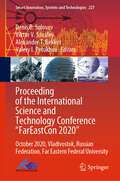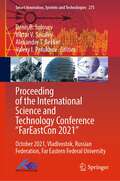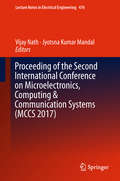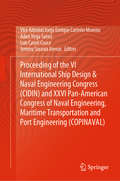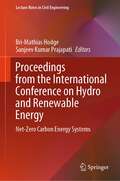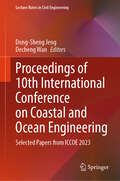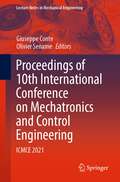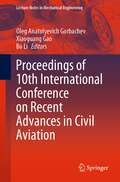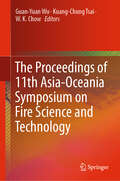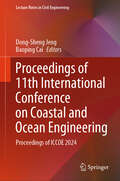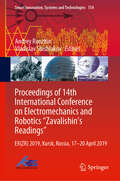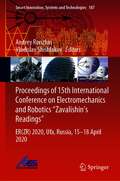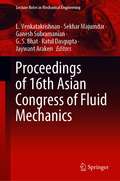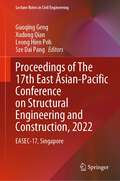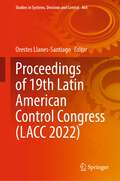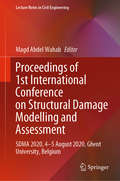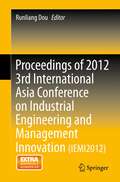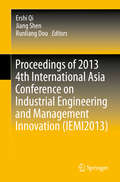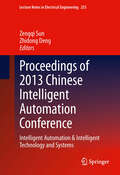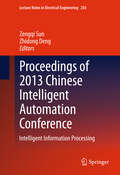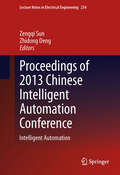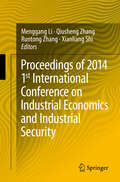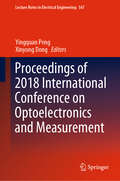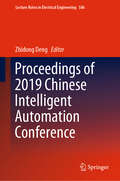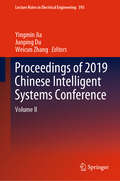- Table View
- List View
Proceeding of the International Science and Technology Conference "FarEastСon 2020": October 2020, Vladivostok, Russian Federation, Far Eastern Federal University (Smart Innovation, Systems and Technologies #227)
by Denis B. Solovev Viktor V. Savaley Alexander T. Bekker Valery I. PetukhovThis book presents the proceedings of the International Science and Technology Conference “FarEastCon 2020,” which took place on October 6–9, 2020, in Vladivostok, Russian Federation. The conference provided a platform for gathering expert opinions on projects and initiatives aimed at the implementation of far-sighted scientific research and development and allowed current theoretical and practical advances to be shared with the broader research community. Featuring selected papers from the conference, this book is of interest to experts in various fields whose work involves developing innovative solutions and increasing the efficiency of economic activities.
Proceeding of the International Science and Technology Conference "FarEastСon 2021": October 2021, Vladivostok, Russian Federation, Far Eastern Federal University (Smart Innovation, Systems and Technologies #275)
by Denis B. Solovev Viktor V. Savaley Alexander T. Bekker Valery I. PetukhovThis book presents the proceedings of the International Science and Technology Conference “FarEastCon 2021,” which took place on October 5–8, 2021, in Vladivostok, Russian Federation. The book discusses modern achievements and promising research in the sphere of intelligent technologies in solving real, applied problems in various fields of industry and economic policies of different countries. Featuring selected papers from the conference, this book is of interest to experts in various fields whose work involves developing innovative solutions and increasing the efficiency of economic activities.
Proceeding of the Second International Conference on Microelectronics, Computing & Communication Systems (Lecture Notes in Electrical Engineering #476)
by Vijay Nath Jyotsna Kumar MandalThe volume presents high quality papers presented at the Second International Conference on Microelectronics, Computing & Communication Systems (MCCS 2017). The book discusses recent trends in technology and advancement in MEMS and nanoelectronics, wireless communications, optical communication, instrumentation, signal processing, image processing, bioengineering, green energy, hybrid vehicles, environmental science, weather forecasting, cloud computing, renewable energy, RFID, CMOS sensors, actuators, transducers, telemetry systems, embedded systems, and sensor network applications. It includes original papers based on original theoretical, practical, experimental, simulations, development, application, measurement, and testing. The applications and solutions discussed in the book will serve as a good reference material for future works.
Proceeding of the VI International Ship Design & Naval Engineering Congress (CIDIN) and XXVI Pan-American Congress of Naval Engineering, Maritime Transportation and Port Engineering (COPINAVAL)
by Vice Admiral Jorge Enrique Carreño Moreno Adan Vega Saenz Luis Carral Couce Jymmy Saravia ArenasThis book presents the proceedings of CIDIN and COPINAVAL. The papers present the development of the navy, maritime and riverine industry, contributing to the scientific and technological progress and development in the sector. In 2019 the congresses occurred in Cartagena, Colombia, a reference for science and technology innovation for Latin-American naval industry.
Proceedings from the International Conference on Hydro and Renewable Energy: Net-Zero Carbon Energy Systems (Lecture Notes in Civil Engineering #391)
by Bri-Mathias Hodge Sanjeev Kumar PrajapatiThis book comprises the select peer-reviewed proceedings of the International Conference on Hydro and Renewable Energy (ICHRE 2022). It aims to provide a comprehensive and broad-spectrum picture of the state-of-the-art research and development in the area of renewable energy technologies, grid integration challenges and opportunities, negative emission technologies, role of distributed energy resources in net zero energy carbon systems, role of hydro energy and pumped storage hydro in power sector decarbonization, policies, and regulations in achieving net zero carbon energy systems, among others. This book provides a valuable resource for those in academia and industry working in the fields of renewable energy, civil engineering, mechanical engineering, among others.
Proceedings of 10th International Conference on Coastal and Ocean Engineering: Selected Papers from ICCOE 2023 (Lecture Notes in Civil Engineering #532)
by Dong-Sheng Jeng Decheng WanThis book presents a collection of selected and peer reviewed papers of 10th International Conference on Coastal and Ocean Engineering, which is held during April 14-16, 2023. The conference is co-organized by Taishan University, Shandong, China, technically supported by China University of Petroleum and Concordia University, which aims to bring together innovative academics and industrial experts in the field of coastal and ocean engineering to a common forum. The papers are contributed by various authors from all sectors of academia and industries, exploring cutting-edge solutions and best practices for coastal and ocean engineering. Various topics are discussed in the book, including Coastal infrastructure developments, Hydrodynamics of off shore structures, Marine ecology and environments, Oil spill and environmental hazards, Estuary coastal engineering, Marine energy engineering, underwater engineering, Offshore oil development technology and equipment, the ocean activities platform, etc. The book will serve as a useful reference for post-graduate students, academicians, industry developer and policy makers.
Proceedings of 10th International Conference on Mechatronics and Control Engineering: ICMCE 2021 (Lecture Notes in Mechanical Engineering)
by Giuseppe Conte Olivier SenameThis volume consists of selected peer reviewed papers from the 10th International Conference on Mechatronics and Control Engineering (ICMCE 2021) discussing latest advances in mechanical engineering and dynamic analysis, sensor technology and application, mechanical design and system modelling, control system and engineering, robot design and control engineering, development and performance analysis of functional materials. Additional themes include methodologies, algorithms, applications and knowledge discovery in mechatronics and control engineering. This volume will prove a valuable resource for those in academia and industry.
Proceedings of 10th International Conference on Recent Advances in Civil Aviation (Lecture Notes in Mechanical Engineering)
by Oleg Anatolyevich Gorbachev Xiaoguang Gao Bo LiThe volume comprises proceedings of the 10th International Conference on Recent Advances in Civil Aviation. The contents focus on air traffic control and management, quality control and reliability improvement of radio equipment and avionics, designing and testing aircraft assemblies and mechanisms, reliability improvement of aircraft management systems, aviation enterprise management, etc. There is also emphasis on the current problems and prospects for development of unmanned aircraft systems. This volume will be beneficial to researchers, practitioners, and policy-makers alike.
The Proceedings of 11th Asia-Oceania Symposium on Fire Science and Technology
by Guan-Yuan Wu Kuang-Chung Tsai W. K. ChowThis book features selected papers from the 11th Asia-Oceania Symposium on Fire Science and Technology (AOSFST 2018), held in Taipei, Taiwan. Covering the entire spectrum of fire safety science, it focuses on research on fires, explosions, combustion science, heat transfer, fluid dynamics, risk analysis and structural engineering, as well as other topics. Presenting advanced scientific insights, the book introduces and advances new ideas in all areas of fire safety science. As such it is a valuable resource for academic researchers, fire safety engineers, and regulators of fire, construction and safety authorities. Further it provides new ideas for more efficient fire protection.
Proceedings of 11th International Conference on Coastal and Ocean Engineering: Proceedings of ICCOE 2024 (Lecture Notes in Civil Engineering #423)
by Dong-Sheng Jeng Baoping CaiThis book includes original and peer-reviewed research papers presented at 11th International Conference on Coastal and Ocean Engineering, which was held during August 9–11, 2024. The conference is sponsored by China University of Petroleum (East China), Shandong, China, co-sponsored by Qingdao University of Technology, China, technically supported by Concordia University, Montreal, QC, Canada and Griffith University, Australia, which aims to bring together innovative academics and industrial experts in the field of coastal and ocean engineering to a common forum. This book is intended for researchers, engineers, and advanced postgraduate students in the fields of coastal and ocean engineering. Topics covered in the book include coastal infrastructure developments, marine and offshore wind energy, oil spill and environmental hazards, wastewater disposal, estuary coastal engineering, offshore engineering, port waterway, oil and gas gathering and transferring, hydrodynamics of off shore structures, etc.
Proceedings of 14th International Conference on Electromechanics and Robotics “Zavalishin's Readings”: ER(ZR) 2019, Kursk, Russia, 17 - 20 April 2019 (Smart Innovation, Systems and Technologies #154)
by Andrey Ronzhin Vladislav ShishlakovThis book features selected papers presented at the 14th International Conference on Electromechanics and Robotics ‘Zavalishin’s Readings’ – ER(ZR) 2019, held in Kursk, Russia, on April 17–20, 2019. The contributions, written by professionals, researchers and students, cover topics in the field of automatic control systems, electromechanics, electric power engineering and electrical engineering, mechatronics, robotics, automation and vibration technologies. The Zavalishin's Readings conference was established as a tribute to the memory of Dmitry Aleksandrovich Zavalishin (1900–1968) – a Russian scientist, corresponding member of the USSR Academy of Sciences, and founder of the school of valve energy converters based on electric machines and valve converters energy. The first conference was organized by the Institute of Innovative Technologies in Electromechanics and Robotics at the Saint Petersburg State University of Aerospace Instrumentation in 2006. The 2019 conference was held with the XIII International Scientific and Technical Conference “Vibration 2019”, and was organized by Saint Petersburg State University of Aerospace Instrumentation (SUAI), Saint Petersburg Institute for Informatics and Automation of the Russian Academy of Sciences (SPIIRAS) and the Southwest State University (SWSU) in with cooperation Russian Foundation for Basic Research (project No. 19-08-20021).
Proceedings of 15th International Conference on Electromechanics and Robotics "Zavalishin's Readings": ER(ZR) 2020, Ufa, Russia, 15–18 April 2020 (Smart Innovation, Systems and Technologies #187)
by Andrey Ronzhin Vladislav ShishlakovThis book features selected papers presented at the 15th International Conference on Electromechanics and Robotics “Zavalishin's Readings” – ER(ZR) 2020, held in Ufa, Russia, on 15–18 April 2020. The contributions, written by professionals, researchers and students, cover topics in the field of automatic control systems, electromechanics, electric power engineering and electrical engineering, mechatronics, robotics, automation and vibration technologies. The Zavalishin's Readings conference was established as a tribute to the memory of Dmitry Aleksandrovich Zavalishin (1900–1968) – a Russian scientist, corresponding member of the USSR Academy of Sciences and founder of the school of valve energy converters based on electric machines and valve converters energy. The first conference was organized by the Institute of Innovative Technologies in Electromechanics and Robotics at the Saint Petersburg State University of Aerospace Instrumentation in 2006.
Proceedings of 16th Asian Congress of Fluid Mechanics (Lecture Notes in Mechanical Engineering)
by L. Venkatakrishnan Sekhar Majumdar Ganesh Subramanian G. S. Bhat Ratul Dasgupta Jaywant ArakeriThis book includes select papers presented during the 16th Asian Congress of Fluid Mechanics, held in JNCASR, Bangalore, and presents the latest developments in computational, experimental and theoretical research as well as industrial and technological advances. This book is of interest to researchers working in the field of fluid mechanics.
Proceedings of The 17th East Asian-Pacific Conference on Structural Engineering and Construction, 2022: EASEC-17, Singapore (Lecture Notes in Civil Engineering #302)
by Guoqing Geng Xudong Qian Leong Hien Poh Sze Dai PangThis book presents articles from The 17th East Asian-Pacific Conference on Structural Engineering and Construction, 2022, organized by National University of Singapore. These peer-reviewed articles, authored by professional engineers, academics and researchers, highlight the recent research and developments in structural engineering and construction, embracing the theme- “Towards a Resilient and Sustainable City”. The papers presented in this proceeding provide in-depth discussions with key insights into the future research, development and engineering translation in structural engineering and construction.
Proceedings of 19th Latin American Control Congress (Studies in Systems, Decision and Control #464)
by Orestes Llanes-SantiagoThis book presents the main results of the 19th Latin American Congress of Automatic Control held in November 2022 in Havana, Cuba. The Congress showed several main research results obtained by researchers from diverse countries in the last four years.Of the papers sent to Congress, 28 were finally accepted for presentation after a rigorous analysis of scientific novelty and quality. For their presentation in this book, the papers were divided into 5 major sections that appear in the following order:Part 1. Robust and Nonlinear ControlThe main research topics addressed in this part are related to fault-tolerant control loops, control by sliding modes, and robust tuning of PID controllers. Examples of electrical motors and chemical processes are used to demonstrate the feasibility of using the proposed techniques.Part 2. Fault Diagnosis in Industrial SystemsFault diagnosis in industrial plants is a very important topic in the Industry 4.0 paradigm. In this part, new techniques of fault diagnosis in mechanical systems using Poincaré features; a real case study for predicting the time of the remaining job cycle at a water treatment plant; and a predictive fault diagnosis for isolated photovoltaic systems are presented. A novel methodology for detecting and locating cyber-attacks in water distribution networks using computational intelligence tools is also presented.Part 3. Robotic and Autonomous SystemsNew control strategies for path following for autonomous tractors and unmanned aquatic vehicles are analyzed in this part. Moreover, the important topic related to the battery health-aware model predictive control planning for autonomous racing vehicles and the use of robots for monitoring and remediation applications are examined.Part 4. Modeling, Identification, and Delayed SystemsA model-based methodology for the efficient selection of centrifugal pumps; the use of probabilistic Boolean networks in smart grid models; the utilization of PSO metaheuristic algorithm in the selection of a model structure; and two schemes to control high-order delayed systems are among the main topics examined in this part.Part 5. Low-Cost Systems and Biomedical ApplicationsIn this part, some applications of low-cost monitoring and control systems and two automatic systems used for the characterization of creatinine in wastes samples during hemodialysis process and differential acquisition of blood pressure are shown.
Proceedings of 1st International Conference on Structural Damage Modelling and Assessment: SDMA 2020, 4-5 August 2020, Ghent University, Belgium (Lecture Notes in Civil Engineering #110)
by Magd Abdel WahabThis book comprises the select proceedings of Structural Damage Modelling and Assessment (SDMA 2020) presented online on 4–5 August 2020. It discusses the recent advances in fields related to damage modelling, damage detection and assessment, non-destructive testing and evaluation, structure integrity and structural health monitoring. The conference covers all research topics and applications relevant to structural damage modelling and assessment using theoretical, numerical and experimental techniques. This book is useful to scientists and engineers in academia and industry who are interested in the field of structural damage and integrity.
Proceedings of 2012 3rd International Asia Conference on Industrial Engineering and Management Innovation (IEMI2012)
by Runliang DouThe purpose of the 2012 3rd International Asia Conference on industrial engineering and management innovation (IEMI2012) is to bring together researchers, engineers and practitioners interested in the application of informatics to industrial engineering and management innovation.
Proceedings of 2013 4th International Asia Conference on Industrial Engineering and Management Innovation (IEMI2013)
by Ershi Qi Jiang Shen Runliang DouThe purpose of the 4th International Asia Conference on Industrial Engineering and Management Innovation (IEMI 2013) is to bring together researchers, engineers and practitioners interested in the application of informatics to usher in new advances in the industrial engineering and management fields.
Proceedings of 2013 Chinese Intelligent Automation Conference: Intelligent Automation & Intelligent Technology and Systems
by Zengqi Sun Zhidong DengProceedings of the 2013 Chinese Intelligent Automation Conference presents selected research papers from the CIAC'13, held in Yangzhou, China. The topics include e.g. adaptive control, fuzzy control, neural network based control, knowledge based control, hybrid intelligent control, learning control, evolutionary mechanism based control, multi-sensor integration, failure diagnosis, and reconfigurable control. Engineers and researchers from academia, industry, and government can gain an inside view of new solutions combining ideas from multiple disciplines in the field of intelligent automation. Zengqi Sun and Zhidong Deng are professors at the Department of Computer Science, Tsinghua University, China.
Proceedings of 2013 Chinese Intelligent Automation Conference: Intelligent Information Processing
by Zengqi Sun Zhidong DengProceedings of the 2013 Chinese Intelligent Automation Conference presents selected research papers from the CIAC'13, held in Yangzhou, China. The topics include e.g. adaptive control, fuzzy control, neural network based control, knowledge based control, hybrid intelligent control, learning control, evolutionary mechanism based control, multi-sensor integration, failure diagnosis, and reconfigurable control. Engineers and researchers from academia, industry, and government can gain an inside view of new solutions combining ideas from multiple disciplines in the field of intelligent automation. Zengqi Sun and Zhidong Deng are professors at the Department of Computer Science, Tsinghua University, China.
Proceedings of 2013 Chinese Intelligent Automation Conference: Intelligent Automation
by Zengqi Sun Zhidong DengProceedings of the 2013 Chinese Intelligent Automation Conference presents selected research papers from the CIAC'13, held in Yangzhou, China. The topics include e.g. adaptive control, fuzzy control, neural network based control, knowledge based control, hybrid intelligent control, learning control, evolutionary mechanism based control, multi-sensor integration, failure diagnosis, and reconfigurable control. Engineers and researchers from academia, industry, and government can gain an inside view of new solutions combining ideas from multiple disciplines in the field of intelligent automation. Zengqi Sun and Zhidong Deng are professors at the Department of Computer Science, Tsinghua University, China.
Proceedings of 2014 1st International Conference on Industrial Economics and Industrial Security
by Menggang Li Qiusheng Zhang Runtong Zhang Xianliang ShiThis book collects 88 papers on the latest fundamental advances in the state of the art and practice of industrial economics and industrial security theories and practices, providing insights to address problems concerning the national economy, social development and economic security. The book is divided into four main sections: Industrial Economics; Industrial Security; Empirical Studies; and others, all of which cover different aspects, such as industrial organization, industrial structure, industrial development, industrial distribution and industrial policies, as well as theories on industrial security in globalization. It also covers four special sessions: Cultural Industry; National Economy; Finance Groups; and International Economics and Trade. The papers in each section describe state-of-art research works that are often oriented towards real-world applications and highlight the benefits of related methods and techniques for developing the emerging field of Industrial Economics and Industrial Security.
Proceedings of 2018 International Conference on Optoelectronics and Measurement (Lecture Notes in Electrical Engineering #567)
by Yingquan Peng Xinyong DongThis book gathers selected papers from the first International Conference on Optoelectronics and Measurement (ICOM 2018), held in Hangzhou, China on Oct 18-20, 2018. The proceedings focus on the latest developments in the fields of optics, photonics, optoelectronics, sensors, and related measurement technologies. Addressing hot topics in fibre optics, photo detectors and sensors, it also features illustrations of advanced device technologies, explains measurement principles, and shares cutting-edge scientific and technological findings. Accordingly, readers will gain essential insights into the forefront of these fields, and will find not only important technical data, but also new ideas to inspire their own future research.
Proceedings of 2019 Chinese Intelligent Automation Conference (Lecture Notes in Electrical Engineering #586)
by Zhidong DengThe proceedings present selected research papers from the CIAC2019, held in Jiangsu, China on September 20-22, 2019. It covers a wide range of topics including intelligent control, robotics, artificial intelligence, pattern recognition, unmanned systems, IoT and machine learning. It includes original research and the latest advances in the field of intelligent automation. Engineers and researchers from academia, industry, and government can gain valuable insights into solutions combining ideas from multiple disciplines in this field.
Proceedings of 2019 Chinese Intelligent Systems Conference: Volume II (Lecture Notes in Electrical Engineering #593)
by Yingmin Jia Junping Du Weicun ZhangThis book showcases new theoretical findings and techniques in the field of intelligent systems and control. It presents in-depth studies on a number of major topics, including: Multi-Agent Systems, Complex Networks, Intelligent Robots, Complex System Theory and Swarm Behavior, Event-Triggered Control and Data-Driven Control, Robust and Adaptive Control, Big Data and Brain Science, Process Control, Intelligent Sensor and Detection Technology, Deep learning and Learning Control, Guidance, Navigation and Control of Aerial Vehicles, and so on. Given its scope, the book will benefit all researchers, engineers, and graduate students who want to learn about cutting-edge advances in intelligent systems, intelligent control, and artificial intelligence.
